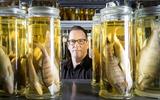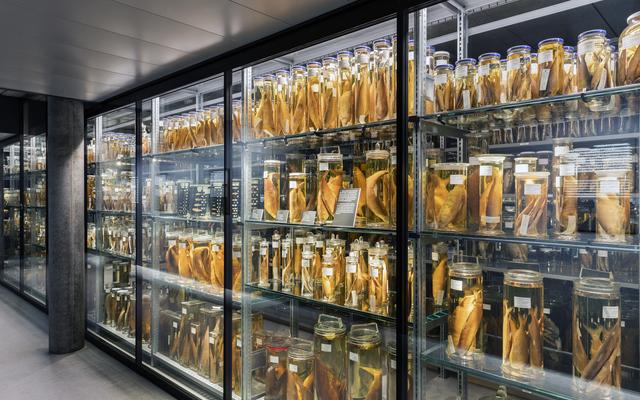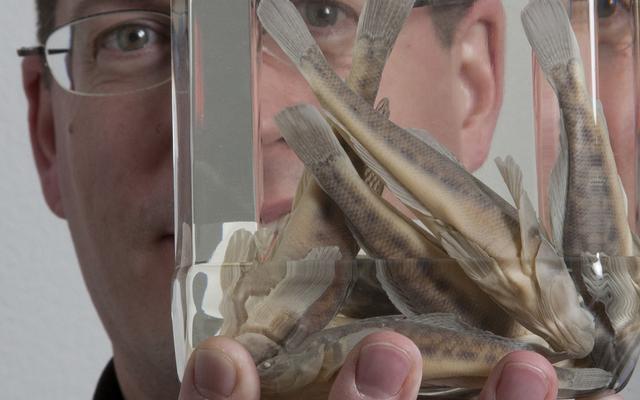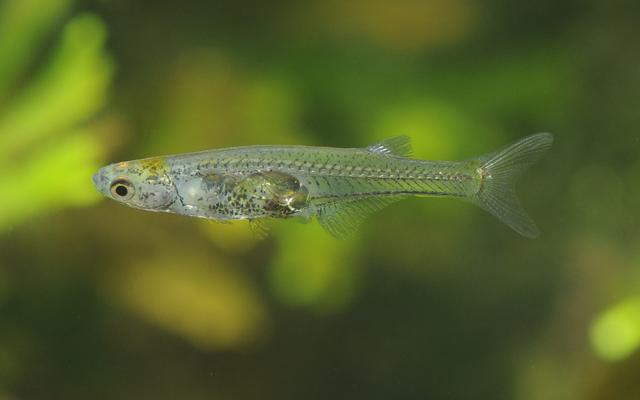Kontakt
- Telefon
- +41 31 350 72 82
- Netzwerk
- ResearchGate GoogleScholar
Conte-Grand C, Britz R, Dahanukar N, Raghavan R, Pethiyagoda R, Tan HH, Hadiaty RK, Yaakob NS, Rüber L (2017). Barcoding snakeheads (Teleostei, Channidae) revisited: Discovering greater species diversity and resolving perpetuated taxonomic confusions. PLoS One, https://doi.org/10.1371/journal.pone.0184017
Malmstrøm M, Britz R, Matschiner M, Tørresen OK, Hadiaty RK, Yaakob N, Tan HH, Jakobsen KS , Salzburger W, Rüber L (2017). The most developmentally truncated fishes show extensive Hox gene loss and miniaturized genomes. bioRxiv 160168, doi.org/10.1101/160168 (preprint publication).
Parson PJ, Bridle JR, Rüber L and M. Genner (2017). Evolutionary divergence in life history traits among populations of the Lake Malawi cichlid fish Astatotilapia calliptera. Ecology and Evolution, 7, 8488–8506.
Beck SV, Carvalho GR, Barlow A, Rüber L, Tan HH, Nugroho E , Wowor D , Mohd Nor SA, Herder F , Muchlisin ZA and de Bruyn M (2017). Plio-Pleistocene phylogeography of the Southeast Asian Blue Panchax killifish, Aplocheilus panchax. PLoS One, 12(7):e0179557
Milá B, Van Tassell JL, Calderón JA, Rüber L and Zardoya R (2017). Cryptic lineage divergence in marine environments: genetic differentiation at multiple spatial and temporal scales in the widespread intertidal goby Gobiosoma bosc. Ecology and Evolution, 7, 5514–5523
Conway KW, Kim D, Rüber L, Espinosa Pérez HS and Hastings PA (2017). Molecular systematics of the New World clingfish genus Gobiesox (Teleostei: Gobiesocidae) and the origin of a freshwater clade. Molecular Phylogenetics and Evolution, 112, 138–147.
Day JJ, Fages A, Brown KJ, Vreven EJ, Stiassny MLJ, Bills R, Friel JP and Rüber L (2017). Multiple independent colonization into the Congo Basin during the continental radiation of African Mastacembelus spiny eels. Journal of Biogeography, 44, 2308–2318.
Winkelmann K, Rüber L & Genner MJ (2017). Lake level fluctuations and divergence of cichlid fish ecomorphs in Lake Tanganyika, Hydrobiologia, 791, 21-34.
Ford AGP, Rüber L, Newton J, Dasmahapatra KK, Balarin JD, Bruun K and Day JJ. (2016). Niche divergence facilitated by fine-scale ecological partitioning in a recent cichlid fish adaptive radiation. Evolution, 70, 2718-2735.
Polgar G, Zane L, Babbucci M, Barbisan F, Patarnello T, Rüber L and Papetti C. (2016). Corrigendum to “Phylogeography and demographic history of two widespread Indo-Pacific mudskippers (Gobiidae: Periophthalmus)” [Mol. Phylogenet. Evol. 73 (2014) 161–176]. Molecular Phylogenetics and Evolution, 100, 268.
Hubert H, Kadarusman, Wibowo A, Busson F, Caruso D,Sulandari S, Nafiqoh N, Pouyaud L, Rüber L, Avarre J-C,Herder F, Hanner R, Keith P, Hadiaty RK (2015). DNA Barcoding Indonesian freshwater fishes: challenges and prospects, DNA Barcodes, 3, 144–169.
Collins RA, Britz R, Rüber L (2015). Phylogenetic systematics of leaffishes (Teleostei: Polycentridae, Nandidae), Journal of Zoological Systematics and Evolutionary Research, 53, 259-272.
Ford AG, Dasmahapatra KK, Rüber L, Gharbi K, Cezard T & Day JJ (2015). High levels of interspecific gene flow in an endemic cichlid fish adaptive radiation from an extreme lake environment, Molecular Ecology, 24, 3421-3440.
Conway KW, Britz R, Shrestha J, Manimekalan A & Rüber L (2015). Molecular systematics of the Asian torrent minnows (Ostariophysi: Psilorhynchidae) inferred from nuclear and mitochondrial DNA sequence data, Journal of Zoological Systematics and Evolutionary Research, 53, 33-44.
Britz R, Conway KW & Rüber L (2014). Miniatures, morphology and molecules: Paedocypris and its phylogenetic position (Teleostei, Cypriniformes), Zoological Journal of the Linnean Society, 172, 556-615.
Rocha LA, Aleixo A, Allen G, Almeda F, Baldwin CC, Barclay MVL, Bates JM, Bauer AM, Benzoni F, Berns CM, Berumen ML, Blackburn DC, Blum S, Bolaños F, Bowie RCK, Britz R, Brown RM, Cadena CD, Carpenter K, Ceríaco LM, Chakrabart P, Chaves G, Choat JH, Clements KD, Collette BB, Collins A, Coyne J, Cracraft J, Daniel T, de Carvalho MR, de Queiroz K, Di Dario F, Drewes R, Dumbacher JP, Engilis JrA, Erdmann MV, Eschmeyer W, Feldman CR, Fisher BL, Fjeldså J, Fritsch PW, Fuchs J, Getahun A, Gill A, Gomon M, Gosliner T, Graves GR, Griswold CE, Guralnick R, Hartel K, Helgen KM, Ho H, Iskandar DT, Iwamoto T, Jaafar Z,, James HF, Johnson D, Kavanaugh D, Knowlton N, Lacey E, Larson HK, Last P, Leis JM, Lessios H, Liebherr J, Lowman M, Mahler DL, Mamonekene V, Matsuura K, Mayer GC, Mays JrH, McCosker J, McDiarmid RW, McGuire J, Miller MJ, Mooi R, Mooi RD, Moritz C, Myers P, Nachman MW, Nussbaum RA, Foighil DÓ, Parenti LR, Parham JF, Paul E, Paulay G, Pérez-Emán J, Pérez-Matus A, Poe S, Pogonoski J, Rabosky DL, Randall JE, Reimer JD, Robertson DR, Rödel M-O, Rodrigues MT, Roopnarine P, Rüber L, Ryan MJ, Sheldon F, Shinohara G, Short A, Simison WB, Smith-Vaniz WF, Springer VG, Stiassny M, Tello JG, Thompson CW, Trnski T, Tucker P, Valqui T, Vecchione M, Verheyen E, Wainwright PC, Wheeler TA, White WT, Will K, Williams JT, Williams G, Wilson EO, Winker K, Winterbottom R & Witt CC (2014). Specimen collection: An essential tool. Science, 344, 814-81.
Britz R, Rüber L & Johnson GD (2014). Reinventing the disc: a reminder to give credit to past giants, Proceedings of the Royal Society B, 281, 20132920.
Winkelmann K, Genner MJ, Takahashi T & Rüber L (2014). Competition-driven speciation in a cichlid fish. Nature Communications, 5, 3412.
Polgar G, Zane L, Babbucci M, Barbisan F, Patarnello T, Rüber L & Papetti C (2014). Phylogeography and demographic history of two widespread Indo-Pacific mudskippers (Gobiidae: Periophthalmus). Molecular Phylogenetics and Evolution, 73, 161-176.
Agorreta A, San Mauro D, Schliewen U, Van Tassell JL, Kovačić M, Zardoya R & Rüber L (2013). Molecular phylogenetics of Gobioidei and phylogenetic placement of European gobies. Molecular Phylogenetics and Evolution, 69, 619–633.
De Bruyn M, Rüber L, Nylinder S, Stelbrink, B, Lovejoy NR, Lavoué S, Tan HH, Nugroho E, Wowor D, Ng PKL, Aziz MNS, von Rintelen T, Hall R & Carvalho GR (2013). Paleo-drainage basin connectivity predicts evolutionary relationships across three Southeast Asian biodiversity hotspots. Systematic Biology, 62, 398-410.
Agorreta A & Rüber L (2012). A standardized reanalysis of molecular phylogenetic hypotheses of Gobioidei. Systematics and Biodiversity, 10, 375–390.
Brown KJ, Britz R, Bills R, Rüber L & Day JJ (2011). Pectoral fin loss in the Mastacembelidae: a new species from Lake Tanganyika. Journal of Zoology, 284, 286-293.
Brown KJ, Rüber L, Roger Bills R & Day JJ (2010). Mastacembelid eels support Lake Tanganyika as an evolutionary hotspot of diversification. BMC Evolutionary Biology, 10: 188. (Highly accessed)
Takahashi T, Watanabe K, Munehara H, Rüber L & Hori M (2009). Evidence for divergent natural selection of a Lake Tanganyika cichlid inferred from repeated radiations in body size. Molecular Ecology, 18, 3110-3119. See also Molecular Ecology perspective article in the same issue by ME Arnegard entitled “Ecological divergence in an emerging genomic model” discussing our research.
Britz R, Conway KW & Rüber L (2009). Spectacular morphological novelty in a miniature cyprinid fish, Danionella dracula n. sp. Proceedings of the Royal Society, Series B. 276, 2179-2186.
Albert EM, San Mauro D, García-París M, Rüber L & Zardoya R. (2009). Effect of taxon sampling on recovering the phylogeny of squamate reptiles based on complete mitochondrial genome and nuclear gene sequence data. Gene 441, 12-21.
Papetti C, Liò P, Rüber L, Patarnello T & Zardoya R. (2007). Antarctic fish mitochondrial genomes lack ND6 gene. Journal of Molecular Evolution, 65: 519-528.
Rüber L, Kottelat M, Tan HH, Ng PKL & Britz R (2007). Evolution of miniaturization and the phylogenetic position of Paedocypris, comprising the worlds smallest vertebrate. BMC Evolutionary Biology,7: 38. (Highly accessed)
Rüber L, Britz R & Zardoya R (2006). Molecular phylogenetics and evolutionary diversification of labyrinth fishes (Perciformes: Anabantoidei). Systematic Biology, 55: 374-397.
Atarhouch A, Rüber L, Gonzales EG, Albert, EM, Rami, M, Dakkak A & Zardoya R (2006). Signature of an early genetic bottleneck in a population of Maroccan sardines (Sardina pilchardus). Molecular Phylogenetics and Evolution, 39, 373-383.
Cunha RL, Castilho R, Rüber L & Zardoya R (2006). Patterns of cladogenesis in the venomous marine gastropod genus Conus from the Cape Verde Islands. Systematic Biology, 54, 634-650.
Rüber L, & Zardoya R (2005). Rapid cladogenesis in marine fishes revisited. Evolution, 59, 1119-1127.
Rüber L, Kullander SO, Britz R & Zardoya R (2004). Evolutionary and biogeographic patterns of the Badidae (Teleostei: Perciformes) inferred from mitochondrial and nuclear DNA sequence data. Molecular Phylogenetics and Evolution, 32, 1010-1022.
Rüber L, Britz R, Tan HH, Ng PKL & Zardoya R (2004). Evolution of mouthbrooding and life-history correlates in the fighting fish genus Betta. Evolution, 58, 798—813.
Rüber L, Van Tassell JL & Zardoya R (2003). Rapid speciation and ecological divergence in the American seven-spined gobies (Gobiidae, Gobiosomatini) inferred from a molecular phylogeny. Evolution, 57, 1584-1598.
Taylor M, Rüber L, & Verheyen E (2001). Microsatellites reveal high levels of population substructuring in the species-poor eretmodine cichlid lineage from Lake Tanganyika. Proceedings of the Royal Society, Series B. 268, 803-808.
Rüber L, Meyer A, Sturmbauer C & Verheyen E (2001). Population structure in two sympatric species of the Lake Tanganyika cichlid tribe Eretmodini: evidence for introgression. Molecular Ecology, 10, 1207-1225.
Rüber L & Adams DC (2001). Evolutionary convergence of body shape and trophic morphology in cichlids from Lake Tanganyika. Journal of Evolutionary Biology, 14, 325-332.
Sturmbauer C, Baric S, Salzburger W, Rüber L & Verheyen E (2001). Lake level fluctuations synchronize genetic divergence of cichlid fishes in African lakes. Molecular Biology and Evolution, 18, 144-154.
Verheyen E & Rüber L (2000). Conservation of the endemic cichlids of Lake Tanganyika, implications from population-level studies based on mitochondrial DNA. Advances in Ecological Research, 31: 539-551.
Rüber L, Verheyen E & Meyer A (1999). Replicated evolution of trophic specializations in an endemic cichlid fish lineage from Lake Tanganyika. Proceedings of the National Academy of Sciences USA. 96, 10230-10235.
Huysseune A, Rüber L & Verheyen E (1999). A single tooth replacement pattern generates diversity in the dentition of the tribe Eretmodini endemic to Lake Tanganyika (Teleostei, Cichlidae). Belgian Journal of Zoology 129, pp 157-174.
Verheyen E, Rüber L, Snoeks J & Meyer A (1996). Mitochondrial phylogeography of rock-dwelling cichlid fishes reveals evolutionary influence of historical lake level fluctuations of Lake Tanganyika, Africa. Philosophical Transactions of the Royal Society London. 351, 797-805.
Snoeks J, Rüber L & Verheyen E (1994). The Tanganyika problem: comments on the taxonomy and distribution patterns of its cichlid fauna. Archiv für Hydrobiologie, Beiheft Ergebnisse der Limnologie. 44: 355-372.
EDITED BOOKS
Biotic Evolution and Environmental Change in Southeast Asia; eds Gower D, Johnson KG, Richardson JE, Rosen BR, Rüber L, Williams ST (2012). Systematics Association Special Volume Series, Cambridge University Press.
BOOK CHAPTERS
Gower D, Johnson KG, Richardson JE, Rosen BR, Rüber L, Williams ST (2012). Introduction. in Biotic Evolution and Environmental Change in Southeast Asia (eds Gower D, Johnson KG, Richardson JE, Rosen BR, Rüber L, Williams ST), pp 1-15. Systematics Association Special Volume Series, Cambridge University Press.
Rüber L & Agorreta A (2011). Molecular systematics of gobioid fishes. in The Biology of Gobies (eds. RA Patzner, JL Van Tassell, Kovacic M & BG Kapoor), pp 23-50. Science Publishers Inc., Enfield, USA.
Rüber L (2009). Labyrinth fishes (Anabantoidei). in The Timetree of Life (eds S. B. Hedges & S. Kumar), pp 344-347. Oxford University Press, New York, USA.
Rüber L, Verheyen E, Sturmbauer C & Meyer A (1998). Lake level fluctuations and speciation in a rock-dwelling cichlid tribe endemic to Lake Tanganyika. in Evolution on Islands (ed P Grant), pp 225-240. Oxford University Press, Oxford, UK.
Sturmbauer C, Verheyen E, Rüber L & Meyer A (1997). Phylogeographic patterns in populations of cichlid fishes from rocky habitats in Lake Tanganyika. in Molecular Systematics of Fishes (eds T Kocher & C Stepien), pp 93-107. Academic Press, San Diego, USA.
ARTICLES IN POPULAR JOURNALS
Rüber L (2000). Evoluzione dei Cichlidi del lago Tanganica. Aquarium, 6, 18-25.
Rüber L (1998). Herkunft der Tanganjikasee-Cichliden. DATZ-Sonderheft Tanganjikasee, 36-39.
Rüber L (1998). Die Gattungsgruppe Eretmodini: Untersuchungen zur Stammesgeschichte. DATZ-Sonderheft Tanganjikasee, 36-39.
Rüber L (1991). Cichliden in der Wissenschaft. DCG-Info, 22, 162-164.
Rüber L (1990). Cichliden in der Wissenschaft. DCG-Info, 21, 259-260.
Rüber L (1990). Cichliden in der Wissenschaft. DCG-Info, 21, 94-96.
My main research interest is in line with one of the central themes in evolutionary biology, namely understanding the processes that contribute to the origin and maintenance of biodiversity. The diversity of recent species is not equally distributed among taxonomic groups and across the globe - a small number of clades accounts for a large part of the world's diversity and a number of relatively small areas with high levels of endemism are populated by unusually large numbers of species. I study patterns and processes of diversification at different spatial and temporal scales by focusing on fish adaptive radiations and biodiversity hotspots. My main research themes are:
1) Biodiversity of Southeast Asian freshwater fishes
Some of the world's hyperdiverse areas, but at the same time most threatened biota are located in Southeast Asia. These biodiversity hotspots comprise important systems for investigating the processes of evolutionary diversification; a prerequisite to document, explain, and conserve the diversity of life we observe today. The freshwater ichthyofauna of Southeast Asia with around 2100 valid species, and an estimated total number of 3000 species is still poorly known, as well as the biogeographic history of the region. One of my long-term goals in this research area is to produce comparative DNA data for a number of Southeast Asian freshwater fish clades (e.g. labyrinth fishes, snakeheads, cyprinids) to address general questions regarding the origin and maintenance of biodiversity (biogeography, diversification patterns, community assembly). A focus is made on ichthyofauna of the Southeast Asian peat swamp forests, a diverse, but very neglected fauna that is critically endangered due to large scale habitat destructions.
2) Miniaturization: Developmental truncation and the evolution of novelty
I have a longstanding research interest in Paedocypris, a fish genus from the highly endangered peat swamp forest habitats in Sundaland, that comprises the smallest fish species with 9.7 mm, Paedocypris progentica. My research focuses on the phylogenetic position of Paedocypris with a strong focus on the recurrent evolution of miniaturization either through proportionate dwarfism or developmental truncation in the zebrafish relatives. We have shown that there is an association between developmental truncation and evolutionary novelty in this fish group. Our description of Danionella dracula received world-wide media attention and received the Top Ten New Species Award in 2010. To better understand the genomic consequences of developmental truncation we have sequenced two Paedocypris genomes and found genome miniaturization and extensive Hox gene loss in Paedocypris.
3) Evolution of gobies
Gobies are small fishes normally between 4 to 10 cm inhabiting most freshwaters, brackish, and marine habitats. With over 2500 species, gobies show a spectacular variety in morphology, behaviour, and ecology. They are well renown for their associations with various marine invertebrates, their cleaning behaviour, or their mutualistic associations with snapping shrimps. Major ecological shifts associated with evolutionary novelties in morphology or physiology characterizes many gobioid groups, as for example the amphibious mudskippers and the amphidromous freshwater rock-climbing gobies. By virtue of their abundance and diversity in coastal ichthyoplankton, cryptic tropical reef fish communities, freshwater streams of tropical oceanic islands, and estuarine benthos, gobioids play key roles in community structure and trophic dynamics of almost all coastal, shallow, marine habitats. Despite their evolutionary and ecological importance, phylogenetic intrarelationships of gobioids are poorly understood. Base on molecular phylogenetic I study various aspects of the evolutionary history of this fascinating group.
4) Mechanisms of speciation in cichlids
Since the publication of Darwin’s 'On the origin of species' 150 years ago, speciation remains one of the most exciting and at the same time least understood evolutionary processes. Recent advances in speciation theory have been both inspired and informed by the adaptive radiations of cichlids of the East African Great Lakes. These lakes harbour over a thousand species, and represent over 10% of the worldwide freshwater fish diversity. In the focus of my research are the cichlid species flocks of Lakes Tanganyika and Natron-Magadi.
Education
Ph.D. 1996-2000. University of Zürich, Switzerland, Faculty of Mathematics and Natural Sciences. Research carried out at the Royal Belgian Institute of Natural Sciences, Brussels, Belgium and at the Department of Ecology and Evolution, State University of New York (SUNY) at Stony Brook, USA.
M.Sc. 1994-1995 University of Zürich, Switzerland, Zoological Museum. Research carried out at the Royal Belgian Institute of Natural Sciences, Brussels, Belgium.
B.Sc. 1989-1994 University of Zürich, Switzerland, Biology.
Academic Positions
2011-present Curator Ichthyology, Naturhistorische Museum der Burgergemeinde Bern
2005-2011 Researcher Ichthyology, Department of Zoology, The Natural History Museum, London, UK.
2000-2005 Postdoctoral fellow Museo Nacional de Ciencias Naturales, Madrid, Spain. Funded by the Swiss National Science Foundation.
1995 Research collaborator, Swiss Federal Institute for Forest, Snow and Landscape Research, and the Zoological Institute of the University of Basel, Switzerland.
1992 Research collaborator, Royal Belgian Institute of Natural Sciences, Brussels, and the Africa Museum, Tervuren, Belgium.
1989 Research assistant, Swiss Federal Institute of Technology, Eawag, Department of Limnology.
Honors and Awards
2013 – 2018. Honorary Lecturer at the Department of Ecology and Evolution, University College London.
2010. Top Ten New Species Award for the description of Danionella dracula Britz, Conway & Rüber 2009. The International Institute for Species Exploration.
2008. Visiting Associate Professor of The University of Tokyo, Ocean Research Institute.
2000. First prize awarded for best Ph.D. dissertation by the Faculty of Mathematics and Natural Sciences, University of Zürich, Switzerland.
Professional Service
2013-present. Editorial board Journal of Zoological Systematics and Evolutionary Research.
2007-present. Board member of the European Ichthyological Society (2007-2015 as treasurer).
2005-present. Editorial board Ichthyological Exploration of Freshwaters.
2007-2011. Council member of the Systematics Association, UK.



